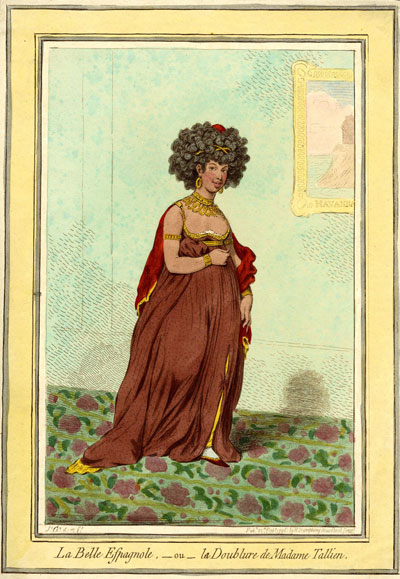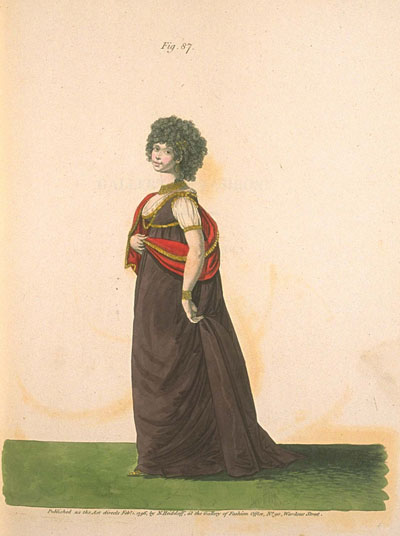La Belle Espagnole, ou la Doublure de Madame Tallien
According to Joseph Monteyne and the National Portrait Gallery, this print shows the mulatto tight-rope dancer, Maria Garcia, who performed under the French stage name of La Belle Espagnole. On the basis of advertisements in numerous papers including the Public Advertiser, the London Daily Universal Register, the London World Fashionable Advertiser, the Morning Post and Daily Advertiser, Morning Chronicle and London Advertiser and others, we know her to have been a regular at Sadler's Wells, performing literally hundreds of times between April of 1785 and August of 1796.

[February 25, 1796]
© Trustees of the British Museum
In keeping with the "Espagnole" in her stage name, La Belle's signature dance upon the rope was a "Fandango with Castanets." But her repertoire also included dancing "with Fetters on her feet," something called "the Prussian Exercises," and a "whimsical pas de deux" danced for many seasons with her fellow performer, "the Little Devil," who also happened to be her husband Paulo Redigé. Before the French Revolution made traveling more complicated, she and the tumbling and tight rope troop led by Signor Placido, seem to have spent from April to late September in Britain and then returned to Paris (from whence they came) for the winter.
But in 1796, though still probably in her 30s, La Belle seems to have abruptly ended her career as a tight-rope artist in mid-season and without explanation. Her last performance at Sadler's was August 30 of that year. The only later mentions I could find of her were in obituary notices in August 1835 for her son, Signor Paulo (earlier Little Paulo) who obviously followed in his father's footsteps as a famous clown and pantomimist.
Gillray makes no allusion to La Belle's career as a tight rope walker except to use her stage name. And his print, published at the end of February, preceded her retirement by six months, so the print seems NOT to have been prompted by any event in her career as a dancer.
Instead it seems to have resulted from a series of events that began with the following notice in the Kentish Weekly Post or Canterbury Journal for Friday 29 January,1796 under the heading of London:
A Spanish Belle of Beauty, rather masculine, made an impressive appearance at the Opera House on Saturday evening — The singularity of her Amazonian dress which was black and scarlet and a circulating buz that she was related to the Republican consort of Tallien secured her the whole stare of the boxes and so discomfited the puny phalanx in Fop's Alley that TERROR was with them "the order of the evening!" (p.4)
That visit to the Opera at the end of January almost certainly led to her appearance (as shown below) in the February, 1796 issue of the Gallery of Fashion by Nicolas Heideloff.

© Pinterest
The caption for that figure: "New Dress, in the Roman Style, introduced at the Opera by a foreign Lady of distinction." is in keeping with Heideloff's stated intent to provide a month to month "collection of all the most fashionable and elegant Dresses in vogue."
The Publisher will make it his particular study to select those magnificent dresses, in which the Ladies appear at the routs, the opera, the play-houses, and the concert-rooms; as well as those elegant morning dresses of Hyde Park, and Kensington Gardens.
A detailed description of the lady and her dress follows:
The hair dressed, without power, into a variety of natural curls; two bands of gold in the hair. Body and petticoat of puce-coloured satin; the body richly embroidered and clasped together over the shoulders. Very short sleeves of fine cambric, the end embroidered in gold. Roman mantle of scarlet kerseymere richly embroidered, all round, in gold, and one end fastened on the right shoulder. large gold ear-rings and bracelets. Broad fancy festoon gold chain round the neck. White satin sandals laced with a gold cord.
In creating this gallery of fashion prints, Heideloff was taking advantage of an interest among British ladies to keep up with Continental, and especially French, fashions. And for those ladies outside of London it must have served as a way of seeing what was au courant in the nation's capital. The enterprise obviously found an audience. Heideloff published the Gallery monthly from 1794 to 1803 eventually restricting copies to subscribers to an entire volume.
Gillray follows the figure and extended description from Heideloff in most respects. He includes the two bands of gold in her hair, the broad festoon chain around her neck, the large gold ear-rings and bracelets, the puce-colored satin body and petticoat, and the scarlet mantle with gold trim.
But he also makes some significant changes. He adds a rug to the floor and a picture labeled "Havanna" in the background to reinforce the Spanish connection and to suggest perhaps a native Cuban heritage. He darkens her skin, gives her more hair, and while retaining the position of the arms, removes the short sleeves of cambric, and turns the entire figure 90 degrees. The result is that we see more of the scooped neckline and decolletage which may have prompted the stares at the Opera and the her mistaken identification as the consort of the Republican Tallien.
For by this time, Madame Tallien was known in England not so much for her role (along with her husband) in helping to bring down Robespierre and the Reign of Terror but as an outrageous fashion leader, one of the so-called Les Merveilleuses (The Marvellous Women) who introduced the Greek Revival Directoire style. Some of the stories that Gillray might have heard included one occasion described in the Wikipedia article on Madame Tallien when she arrived at the Tuileries Palace, "supported by a black page, with eight sapphire rings and six toe rings, a gold bracelet on each ankle and nine bracelets on each arm." Or another occasion when she appeared at the Paris Opera wearing a sheer white silk dress without sleeves and without any underwear. To which French foreign minister Talleyrand is supposed to have said, "One could not be more sumptuously unclothed!"
Gillray often responded to chance opportuunities presented in newspapers and gossip to obtain an addional edge in selling his prints. In 1796, he was already taking advantage of the interest in women's fashion to satirize its excesses in plates like A Modern Belle Going to the Rooms at Bath (January 13), Ladies Dress, As It Soon Will be (January 20,) The Fashionable Mama, of the Convenience of Modern Dress (February 13). And he continued to do so in Lady Godina's Rout, or Peeping Tom Spying Out Pope Joan (March 12). So it is in this context that we should see La Belle Espagnole, ou la Doublure de Madame Tallien (February 25). He must have seen Heideloff's print and seen or heard of the report of the stir caused by the mistaken identification, and realized that he could capitalize on the provocative reputation of Madame Tallien and a similarly provocative dress.
Sources and Reading
- Commentary from the British Museum on La Belle Espagnole, ou la Doublure de Madame Tallien.
- "Thérésa Tallien," Wikipedia
- "Astley's Amphitheatre," Wikipedia
- "Sadler's Wells Theatre," Wikipedia
- "Nicolaus Heideloff," British Museum
- The Gallery of Fashion (1794-1803)
- Les Merveilleuses (The Marvellous Women)
- Thomas Wright and R.H. Evans, Historical and Descriptive Account of the Caricatures of James Gillray #419.
- Thomas Wright and Joseph Grego, The Works of James Gillray, the Caricaturist; With the History of His Life and Times, p. 209-10.
Comments & Corrections
NOTE: Comments and/or corrections are always appreciated. To make that easier, I have included a form below that you can use. I promise never to share any of the info provided without your express permission.